December 2, 2010 | Posted in CLASSIC ROCK | By sockii
The Legendary Classic Rock Band’s Origins, Music and History
How Pink Floyd came to be one of rock music’s most important bands and the inspirations behind their classic albums.
This article was originally published December 2, 2010 at Associated Content/Yahoo! Contributors Network.
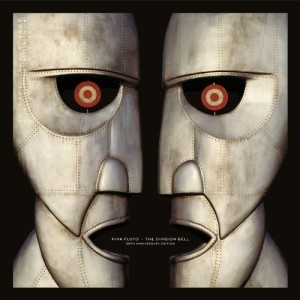
The Division Bell 20th Deluxe Box – Available now at Amazon.com.
“Oh by the way, which one’s Pink?” – Have a Cigar by Pink Floyd, (1975)
Pink Floyd is one of the most successful rock bands of all time, with record sales in excess of 200 million worldwide. Yet at the same time, the individuals who have made up the band through the years have maintained a certain degree of anonymity unusual in the often personality-driven world of rock music, with few people outside of diehard fans and musicians able to name the band’s members.
That might suggest that Pink Floyd could be lacking in interesting personalities or personal dramas, but this is hardly the case. Pink Floyd was, in many ways, a conflict-driven band, with the creativity and brilliance of their work spurred on by the highly differing personalities and ideas of its members. The band has also been haunted by the tragic descent into madness of their first lead singer and guitarist, Syd Barrett, a figure whose presence can be heard and felt from their first record in 1967 right through to the last recorded Pink Floyd album (at the time I originally wrote this piece, at least!) in 1994, The Division Bell.
The beginnings of Pink Floyd
In 1964, Pink Floyd began as “Sigma 6,” though soon changed their name to “The Abdabs.” Consisting of Roger Waters on lead guitar, Clive Metcalf on bass, Richard Wright on keyboards, Nick Mason on drums, and Juliette Gale and Keith Noble on vocals, they were primarily a rhythm and blues cover band. Several personnel and name changes later, and they were in 1965 to become “The Pink Floyd,” featuring the first lineup we are familiar with today: Roger on bass, Rick still on keyboards and Nick still on drums, with Syd Barrett on guitar. They became a regular on the underground club scene including The UFO Club, slowly transitioning from playing psychedelic R&B covers to their own songs, mostly penned by Syd. They were loud, they were weird, and they were also one of the first groups to begin experimenting with light show effects including such odd ideas as bubbling wax projected over a slide slow behind them.
In March 1967 they released their first single, “Arnold Layne,” and their first full length album was soon to follow, Piper at the Gates of Dawn. Even by the time Piper was released, Syd’s behavior was becoming erratic, leading to conflict and stress within the band. Serious drug abuse was largely the suspect, although it is likely he was already suffering from a condition such as schizophrenia or Asperger syndrome that was only aggravated by his heavy acid use. He was unpredictable on stage and at times would simply stand there, staring off into space, distractedly strumming his guitar while the others would struggle through a set.
David Gilmour, who had been a childhood friend of Syd’s, was brought in as a second guitarist to try to cover for Syd’s declining state. For a time it was thought Syd could become the “Brain Wilson” (a la the Beach Boys) of the band, left at home to write while the others toured, but soon they simply decided it was impossible to do anything at all with Syd, and one night they simply didn’t pick him up for a show. They carried on without him entirely from that point forward, dropped the “The” from their name and simply became “Pink Floyd.”
The Experimental Years
The period that would follow from 1968-1970 was very experimental for Pink Floyd, as the band attempted to find new direction without Syd. Their next album, A Saucerful of Secrets, was transitional as it featured one song Syd had written and recorded with them before being kicked out of the band, and the rest with David. It still held much of the psychedelic sound of Piper, although the title track would become somewhat a blueprint for their sound and style for the next several years, being an extended mostly-instrumental experiment of sound, noise, and melody. On stage they would often perform extended jams lasting 10-20 minutes, stretching and taking their album songs into entirely different places. In 1969 they went on their first “concept tour” called “The Man and The Journey,” which featured new and older material structured together into a loose story-line.
The double-album Ummagumma (1969) would follow. One disc was a live set, intended originally as a “farewell” to some of their earlier material, although they ended up having to keep playing it as it was so popular with their fans, especially after the release of the album. The second half of the album was new studio material in four sections, one each written by the four band members.
A soundtrack for the film “More” would be their next project, before the band would tackle another concept piece, Atom Heart Mother, (1970) recorded and toured with an orchestra, the title piece co-written with avant-garde artist Ron Geesin. Soundtrack work on the film “Zabriskie Point” would follow, and then the period of touring between 1970-1971 that would become known as “the glory years” to many fans. During this period, the band’s experimentation on-stage would blossom and some of their wildest, yet most incredible performances would result. Some new songs would be performed that would evolve and turn into the key tracks on Meddle (1971), the album that most would say truly set Pink Floyd on the track it would follow through the rest of the ’70s and lead them to incredible success outside of just the psychedelic scene.
Dark Side of the Moon
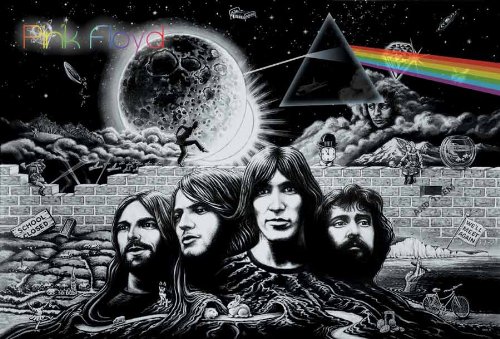
Pink Floyd Dark Side of the Moon Art Poster – Rare New – Image Print Photo available at Amazon.
“Until very recently we were in acute danger of dying of boredom…the thing to do is to really move people — to turn them on, to subject them to a fantastic experience, to do something to stretch their imagination.” – Nick Mason, 1971.
By this point Waters and Gilmour were clearly the primary songwriters of the group as well, although Wright would generally contribute some material along with vocal work, and Mason was influential in some of the more experimental aspects of their albums, including sound effects and more production-related issues.
In 1972 they released Obscured by Clouds, the soundtrack for the film “La Vallee.” It was recorded in a brief break of touring, where they were beginning to perform and tour the material that would soon become Dark Side of the Moon.
No one could have predicted the phenomenon of Dark Side of the Moon, most especially not the band members themselves. By some estimates, one in every twenty people under the age of fifty in the United States owns a copy of the album, which remained on Billboard’s 200 album chart for 15 years straight and then for another two when it was remastered in 1994. With upwards of 40 million copies sold worldwide, it is one of the most successful albums ever. Tackling timeless themes and concerns including madness, death, war, greed, and aging, it is still to some the peak of the Pink Floyd sound and experience. Honed by months of touring and then studio tweaking, it successfully blended Water’s sharp, intelligent writing with Gilmour and Wright’s softer melodic sensibilities, perhaps balancing the two aspects of the band’s sound to a degree they would never be able to achieve quite so successfully again. They would tour throughout 1973 in support of the album and their stage performance would continue to grow more complex and dazzling, with the use of video projection and stage effects such as a crashing model airplane during “On the Run.”
Finding Direction after Dark Side
“…I felt that the only way I could retain interest in the project was to try to make the album relate to what was going on there and then, the fact that no one was really looking each other in the eye, and that it was all very mechanical.” – Roger Waters on recording Wish You Were Here.
Finding a way to follow the huge success of Dark Side would be a daunting task. Pink Floyd experimented for a time with the idea of a “Household Objects” album, using only items used commonly around the house to produce sounds, but it was quickly scrapped. Wish You Were Here would surface in 1975, and the title itself was an ironic statement on the condition of the band itself at that time. Featuring the mournful, extended track “Shine On You Crazy Diamond,” the recording process was stressful, and haunted not only by the presence of Syd summoned by “Shine On” but physically as well, as one day he showed up unexpected and unannounced in the studio, virtually unrecognizable by the decline brought on by his mental state.
“I think we’ve been pretty close to breaking up for years. I’m glad we didn’t because I like the album and look forward to going out and playing it.” – Roger Waters on Animals.
Some of the tracks for Animals (1977) had been toured as early as 1975, though the versions eventually recorded would be significantly different. A tighter concept album than ever, Animals examined people as they related to dogs, sheep and pigs, and was more strongly than ever dominated by Waters. For once Wright had no writing credits on the album, and the sound was darker, more guitar-driven, also featuring Roger’s vocals more dominantly.
Behind The Wall
Touring was becoming tiring and stressful to Waters, who was disgusted that people seemed to be going to their shows less to hear and listen to the music and more just to be part of a scene, to shout and get stoned and go wild. He no longer felt connected to his audience, as if a wall existed between them, one he began to imagine as both physical as well as emotional. This feeling had been growing since the Wish You Were Here tours but were only becoming more acute on the Animals tour. This physical wall would become part of their most elaborate tour production ever in support of the double album The Wall (1979), an album that would come about through much strife and difficulties within the band.
The Wall was easily their most ambitious concept-album yet. It tells the story of “Pink” as an individual, a rock star in torment from his youth (father killed in World War II, raised by an overbearing mother, torturous education) as well as his present (drug abuse, a cheating lover, groupies and mindless fans). He slowly disconnects from the real world, brick by brick isolating himself into his madness until put on trial within his head, whereupon his sentence is to have to destroy the wall. The other band members found Waters’ deeply personal piece difficult to relate to, and he was increasingly unwilling to work with the others as an actual band instead of simply musicians supporting his work. Conflict was particularly strong with Wright, who both Waters and Gilmour felt had not been performing and contributing up to par since Animals and who was also nursing a bad cocaine addiction. Wright would be replaced by other keyboardists on some tracks, and though he would perform on the Wall tour dates, by 1980 he was no longer officially a member of the band.
Because of the complexity of The Wall concert show, it would only be performed in New York, Los Angeles, London and Dortmund. Besides the giant balloons, puppets and projections that had long been a part of the Floyd stage show, this tour would actually feature the construction of a cardboard wall across the stage, completed by the end of the first half of the show, so that the band would perform behind it for most of the second half. Amusingly enough, because of the expense of the Wall live shows, the only Floyd who made any money on the tour was Wright–as he’d been fired from the band, he worked the tour on wage.
Exit Roger Waters
The last Floyd album to feature Roger Waters as the main creative force would be The Final Cut (1983). Conflicts were worse than ever as now Waters was not happy with Mason’s drumming, and Gilmour felt like little more than a studio musician being asked to perform without being able to offer any creative input. Even more personal and political than The Wall, the album was apparently culled from tracks scrapped from The Wall and then expanded into a separate concept album, tackling current events as well such as Britain’s involvement in the Falklands War. There were no large hits such as “Another Brick in the Wall” or “Comfortably Numb,” and no tour in support of the album, and afterward Waters officially “quit” the band, assuming that in his absence, the others would follow suit and Floyd would be no more.
“The strength of Pink Floyd always lay in the talents of all four members. Naturally we will miss Roger’s artistic input, however, we will continue to work together as in the past.” – David Gilmour, 1986.
“When does a band stop being a band? They presumably have the same sort of definition as the people calling themselves The Drifters…I’m out on the road in competition with myself — and I’m losing. I’m sure I would be happier if I could murder them, professionally as Pink Floyd.” – Roger Waters, 1987.
Gilmour would decide, in 1987, that it was time for Floyd to return–with or without Waters, and preferably without. He recorded A Momentary Lapse of Reason with Wall-producer Bob Ezrin and Mason as an official band member (though he may not have played on many tracks on album). Wright would also appear listed as a studio musician on the album (though again, may not have contributed much) and would tour with Mason and Gilmour in support of the album.
Waters was less than pleased with this development. At the time attempting to tour and promote his own new album, Radio K.A.O.S., Waters bristled at Gilmour’s use of the Floyd name and back catalog of songs (which Waters had largely at least co-written). He also found that the group’s long individual anonymity had come back to haunt him, as many going to these ’87 Floyd shows had no idea that anyone was missing from the lineup, and he struggled to half-fill smaller arenas in the same cities that Gilmour and company were selling out stadiums.
Waters would sue Gilmour to stop his use of the name Pink Floyd. Battles would wage back and forth in the press, the fandom, and between the band members past and present. Waters claimed to feel particularly betrayed by Mason’s involvement in Gilmour’s project, as he had long considered Nick to be one of his best friends and supporters within the band. In December 1987, Gilmour persuaded Waters to sign an agreement allowing him to use the Pink Floyd name. Waters, however, refused to allow him to use the band’s giant trademark flying pig balloons. To Waters’ dismay, Gilmour found a solution. “If the pig had been exactly the same as the pig that I designed,” Waters later remarked, “I could have stopped them from using it.”
Gilmour instead designed a modified pig – one with giant porcine testicles.
Tolling the Division Bell
After massive touring and a live cd/video release, Gilmour, Mason and Wright would fall silent for several years, certainly rich enough by this point that they had no need to record again as Floyd unless the desire struck. Waters would release the album Amused to Death, a biting commentary on war, religion, and the media that has only become more relevant and haunting in the years to follow. The last (so far) Floyd studio album, The Division Bell, was released in 1994, and featured more fully the three musicians working together as a group as Wright was now officially back in the fold. Primary song writing credits belonged to Gilmour along with girlfriend-now-wife Polly Samson. Another massive world stadium tour followed, and after that, little else was heard for years.
The Floyd had long supported the idea that pigs could fly, and in the summer of 2005 that really did seem to be the case when news surfaced of a Floyd reunion to take place at the Live8 concert in London. For the first time since The Wall tour, Waters, Gilmour, Wright and Mason performed together on stage for a short but incredibly memorable set. For at least one evening, old battles were put aside and the world was amazed to hear what magic they could still create seemingly effortlessly together.
Reunion Rumors…and The Future?
Rumors were quick to surface that this reunion might lead to a longer performance or tour, but were quickly put to rest as Gilmour was working on his own solo album, On an Island (2006), and seemed to have little interest in making long-term friends again with Waters. Waters, however, seems to have mellowed in his opinion of his former bandmates, and he ended up inviting Mason to join him on his Dark Side of the Moon memorial tour. Wright was also extended an invitation to join them, but he did not, and sadly he would succumb to cancer in 2008.
The legacy of Pink Floyd continues to affect modern rock fans to this day. Their music seems to defy generational boundaries and remains extremely popular with young and old, as proven by Roger Waters’ extremely successful tour of The Wall in 2010. Whether the surviving band members ever reunite on stage again or not, their music has left an indelible mark on the world and will be remembered for decades, if not centuries, to come.
Sources:
* Mason, Nick, and Philip Dodd. Inside Out: a Personal History of Pink Floyd. San Francisco: Chronicle, 2005. Print.
* Miles, Barry, and Andy Mabbett. Pink Floyd: the Visual Documentary. London: Omnibus, 1994. Print.
* The Echoes FAQ – Version 4.0.
* Pink Floyd – Wikipedia.
* Personal experience.
Love Pink Floyd? Then share your opinions about the band in my “Ultimate” Pink Floyd fan survey:
 The Ultimate Pink Floyd Fan Survey
The Ultimate Pink Floyd Fan Survey
Pink Floyd is one of the most popular rock bands of all time. If you’re a Floyd fan, you can take this survey to share your opinions on the band’s greatest songs, albums and much more.
Related posts at Spacial Anomaly
Table of Contents
sockii
sockii is just your typical Jane-of-All-Trades who never has enough time in her day for all of her projects. She has written for many websites online including Squidoo, Zujava, Yahoo! Contributors Network, HubPages and Wizzley. She has been attending and vending at science fiction and media conventions for over 15 years, and for several years ran an art gallery and jewelry store in Philadelphia. Today she is happy to be living in South Jersey with her partner David and their 6 cats. Sockii is a member of several affiliate sales programs including Amazon Associates and Viglink. Products from these services may be advertised on her posts and pages to generate sales commissions.
Leave a Reply
*

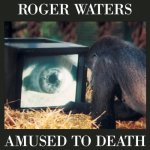
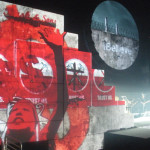
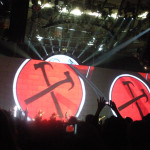
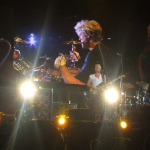








Be the first to comment.